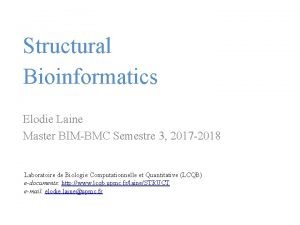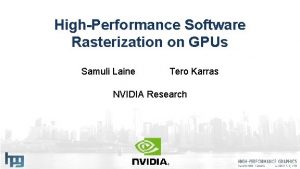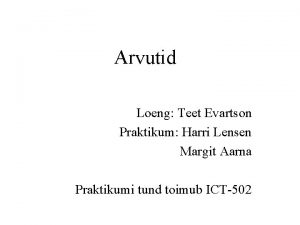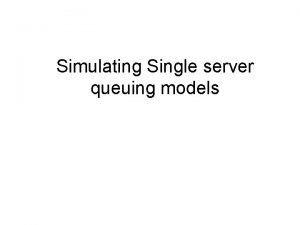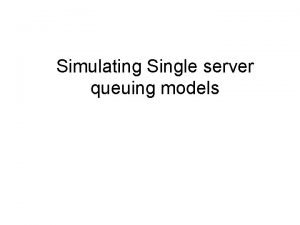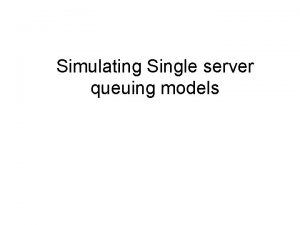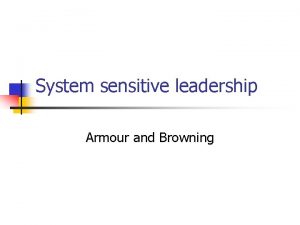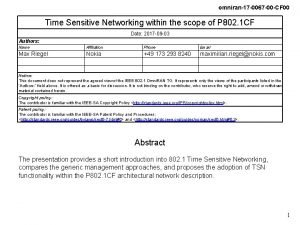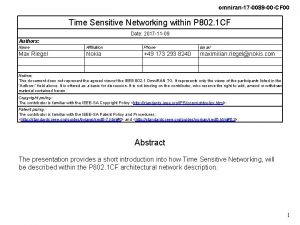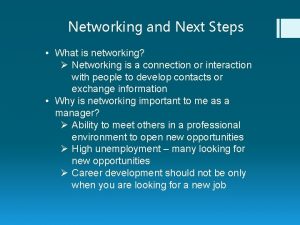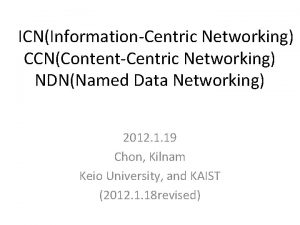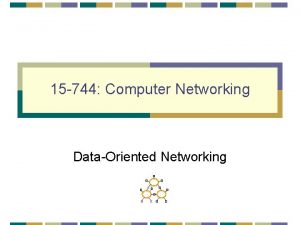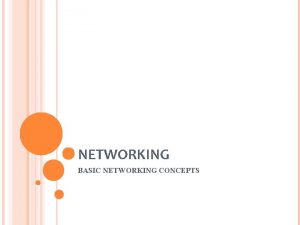Modeling and Simulating Time Sensitive Networking Harri Laine




























- Slides: 28

Modeling and Simulating Time. Sensitive Networking Harri Laine

Overview • Introduction • Time-Sensitive Networking – Background – Goals – Architecture • Simulator – Design – Implementation • Evaluation • Conclusion 2

Introduction – Devices that use network 3

Introduction – Consumer electronics No need for determinism: Ethernet fulfills requirements 4

Introduction – Real-time systems, such as automotive and industrial applications, need determinism: Ethernet does not fulfill requirements 5

Introduction – Problem The requirements lead to having two networks in industrial applications! • one for connecting PCs • one for controlling machinery 6

Time-Sensitive Networking – Background • Prioritization – Allows important data to take preference on transmission – Priority tag included in each frame – Audio/video (AV) transmission and other real-time traffic gets lower latencies • Credit-based shaper – Aimed for AV-streaming – Prevents high priority data to block low priority data – Prevents “bursts” of data in the network 7

Time-Sensitive Networking – Prioritization 8

Time-Sensitive Networking – Prioritization 9

Time-Sensitive Networking – Prioritization alone is not enough to provide guarantees for hard real-time systems! 10

Time-Sensitive Networking – Goals • Provide determinism in Ethernet networks – Protected windows using Gate Control Lists – Cut costs of having two networks – Cut costs of specialized networks • Increase efficiency in Ethernet networks – Preemption – Credit-based shaper 11

Time-Sensitive Networking – Architecture • Gates are used in outbound port to block and allow data to flow • Gate Control List is used to manage gate states (open/closed) 12

Time-Sensitive Networking – Architecture • Architecturally simple • Wires, clocks, queues – Clocks are synchronized in the network 13

Time-Sensitive Networking – Protected windows • Synchronized GCLs can be used to create protected windows • Protected windows create clear communication channel for time-critical data • Makes the network predictable – Suitable for hard real-time systems 14

Time-Sensitive Networking – Credit-based shaper • Restricts high priority data getting all the bandwidth • Prevents “bursts” in network 15

Time-Sensitive Networking – Preemption • Allows frames to be stopped and continued later – Favors high priority data, but utilizes network more efficiently – Low priority data can be send even just before a protected window 16

Simulator – Design • Objectives – Implement TSN features • Protected windows • Credit-based shaper • Preemption – Use input files to generate • Messages • Network • Virtual links (routes) • GCLs – Produce output data for further analysis • Event-based • Randomness for non-time-critical data 17

Simulator – Implementation • Java was chosen to create classes for entities (queues, ports, etc. ) – Based on given simulator • 5 different main parts – Scheduler – Port – Network – Virtual Network – Message • Possibility to run until a stable state • Possibility to define – Input parameters – Maximum difference for stable state – Credit-based shaper bandwidth reservation 18

Simulator – Implementation • Network is split to the whole network and virtual links – Virtual link is a subset of the network 19

Evaluation – Validation • A test run where – be 1 – low priority BE frame – tc 2 – medium priority time-critical frame – be 3 – high priority BE frame – Not a very likely situation but shows that protected windows work! 20

Evaluation – Test cases • Three test cases • Each test case has three variations – Original – Some BE-traffic added – Some more BE-traffic added – BE-traffic added with characteristics in real network • A lot of small (under 100 bytes) and large frames (over 1400 bytes), rest being somewhere between • Test case 1 – 20 TT-frames, 26 AV-frames – 12 ESs, 4 NSs • Test case 2 – 58 TT-frames, 51 AV-frames – 10 ESs, 5 NSs • Test case 3 – 92 TT-frames, 81 AV-frames – 35 ESs, 8 NSs 21

Evaluation – Results: WCD differences for AV -frames • Qbv = protected windows • Qbu = preemption • Qav = credit-based shaper 22

Evaluation – Results: ACD for BE-frames 23

Evaluation – Results: protected windows’ effects • Average WCD of TT-frames Test case Qbv None Difference 1 321 441 37% 3 674 829 23% 3 c 674 916 36% • Average WCD of AV-frames Test case Qbv None Difference 1 588 492 16% 3 133 125 6% 3 c 135 128 5% 24

Evaluation – Results: findings • • 25 Time-critical frames flow through the network as planned Preemption favors AV-frames Credit-based shaper favors BE-frames Preemption + credit-based tries to favor both AV and BE-frames

Evaluation – Limitations • Stable state after three consecutive WCD differences stay within limits – Room for errors • The simulator allows AV-frame to preempt BE-frame at any point, when it has enough credits • Hardware delays are not considered • Only one frame per message • The network is homogeneous • Time accuracy is 80 ns 26

Conclusion • There are still things to determine – When frames can be preempted? – How CBS, protected windows and preemption works together? • The simulator allows studying feature set effects on the network • Protected windows provide timing guarantees • The simulator is fast enough to study small to medium sized networks – Still room to improve its performance 27

Thank you!
 Sdn vs traditional network
Sdn vs traditional network Immediate changes after death
Immediate changes after death Conditions simulating rigor mortis
Conditions simulating rigor mortis Helen c erickson
Helen c erickson Dimensional modeling vs relational modeling
Dimensional modeling vs relational modeling Tiva
Tiva Context sensitive half time
Context sensitive half time Elodie laine
Elodie laine Orifices herniares
Orifices herniares Rh zara
Rh zara Marie madeleine son petit jupon de laine
Marie madeleine son petit jupon de laine Samuli laine
Samuli laine Miks me ei taju osake-laine dualismi mikromaailmas?
Miks me ei taju osake-laine dualismi mikromaailmas? Hernie laine
Hernie laine Samuli laine
Samuli laine Kari laine
Kari laine David laine
David laine Marie madeleine son petit jupon de laine
Marie madeleine son petit jupon de laine Tatu laine
Tatu laine Laine levimiskiirus
Laine levimiskiirus Biography on kobe bryant
Biography on kobe bryant Harri lensen
Harri lensen Harri motak
Harri motak Harri hakaste ympäristöministeriö
Harri hakaste ympäristöministeriö Indexicality
Indexicality Harri saarnisaari
Harri saarnisaari Ville veijola
Ville veijola Suupielen nykiminen
Suupielen nykiminen Harri korhonen
Harri korhonen







